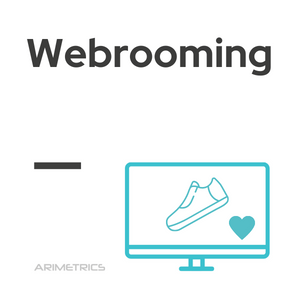 Definition:
Definition:
Webrooming is a term that describes the behavior of consumers who research products online before making a purchase in a physical store. This phenomenon, also known as ROPO (Research Online, Purchase Offline), has gained relevance in digital marketing due to the increasing penetration of the Internet and society’s familiarity with new technologies and mobile devices. Many consumers prefer to find out more about a product before purchasing it, using the web as their main source of information.
What is webrooming for?
Webrooming is a mechanism that helps users to make the best decision when buying any type of product. For companies it can be the best way to position themselves in the market as the best alternative, not only with their presence on the internet but showing the benefits of their products
The goal of webrooming is to drive purchases in face-to-face stores.
What is webrooming for?
Webrooming helps consumers make informed purchasing decisions, allowing them to evaluate different options before visiting a physical store. For companies, it represents an opportunity to stand out in the market by providing valuable online information about their products and services, thus encouraging purchases in physical stores. The goal is to encourage consumers, after researching online, to complete their purchases in physical stores.
Tips for using webrooming effectively
To implement an effective webrooming strategy and increase conversions in physical stores, the following tips can be considered:
- Optimize the website: It is important that the site is well organized, with a structure that facilitates navigation. Provide detailed product descriptions, high quality images and all the necessary information, such as frequently asked questions. Including explanatory videos can further enrich the user experience.
- Design a unified measurement strategy: It is essential to correctly attribute purchases to understand which marketing actions are working. Link online and offline actions through coupons with unique codes or user identifiers.
- Unify inventory: Make it easy for customers to buy online with in-store pickup or provide inventory information for nearby stores.
- Implement a solid SEO strategy: It is useless to have a flawless website if users cannot find it. It is essential to make sure that the site is easily found in search engines.
- Include user reviews: The opinions of other customers are essential to build trust. It is advisable to display these reviews on the website.
- Use retargeting: If users abandon the cart, you can use retargeting strategies, such as display ads or emails, to lure them back and motivate them to complete the purchase in a physical store.
- Offer excellent service both online and in-person: Online, chatbots or social networks can be used to provide close service. Offline, it is important for staff to provide exceptional service when picking up orders in store, taking advantage of this to close complementary sales.
- Offer free shipping and in-store pickup: Allow pickups at nearby stores with no minimum order to remove barriers such as lazy commuting.
- Take care of the return and shipping policy: Facilitate returns to attract customers to physical stores, where they can be encouraged to buy other products.
- Generate engaging experiences in physical stores: Stores can offer unique experiences, such as events, workshops or personalized treatment, which can be shared on social networks to increase visibility and attraction.
Impact of webrooming on the retail trade
Webrooming has had a significant impact on retail, transforming the way consumers interact with brands and make purchases. Some of the main effects are highlighted below:
- Increased traffic to physical stores: By searching for information online and then visiting physical stores, consumers can increase traffic to stores, which in turn can improve sales.
- Change in marketing strategies: Companies have had to adapt their marketing strategies to embrace both digital and physical environments, ensuring a consistent and seamless customer experience.
- Development of new services: To take advantage of webrooming, many stores have developed additional services, such as in-store pickup of products purchased online, which improves convenience for the customer.
Challenges of webrooming for companies
While webrooming offers many opportunities, it also presents certain challenges for companies wishing to capitalize on this trend:
- Channel integration: Companies must effectively integrate their online and physical channels to deliver a seamless shopping experience, which may require significant investments in technology and staff training.
- Inventory management: Maintaining an updated and synchronized inventory between online platforms and physical stores is critical to avoid availability issues and meet customer expectations.
- Price competition: Consumers who practice webrooming often compare prices online, forcing companies to be competitive in their offers and prices to attract shoppers to their physical stores.
- Brand protection: With access to a wealth of information online, companies must ensure that their product information is accurate and consistent to protect their brand reputation.
